Learn how to make hot sauce at home, including hot sauce recipes and tips, fermenting chilies, preserving hot sauce, and how to start a hot sauce business.
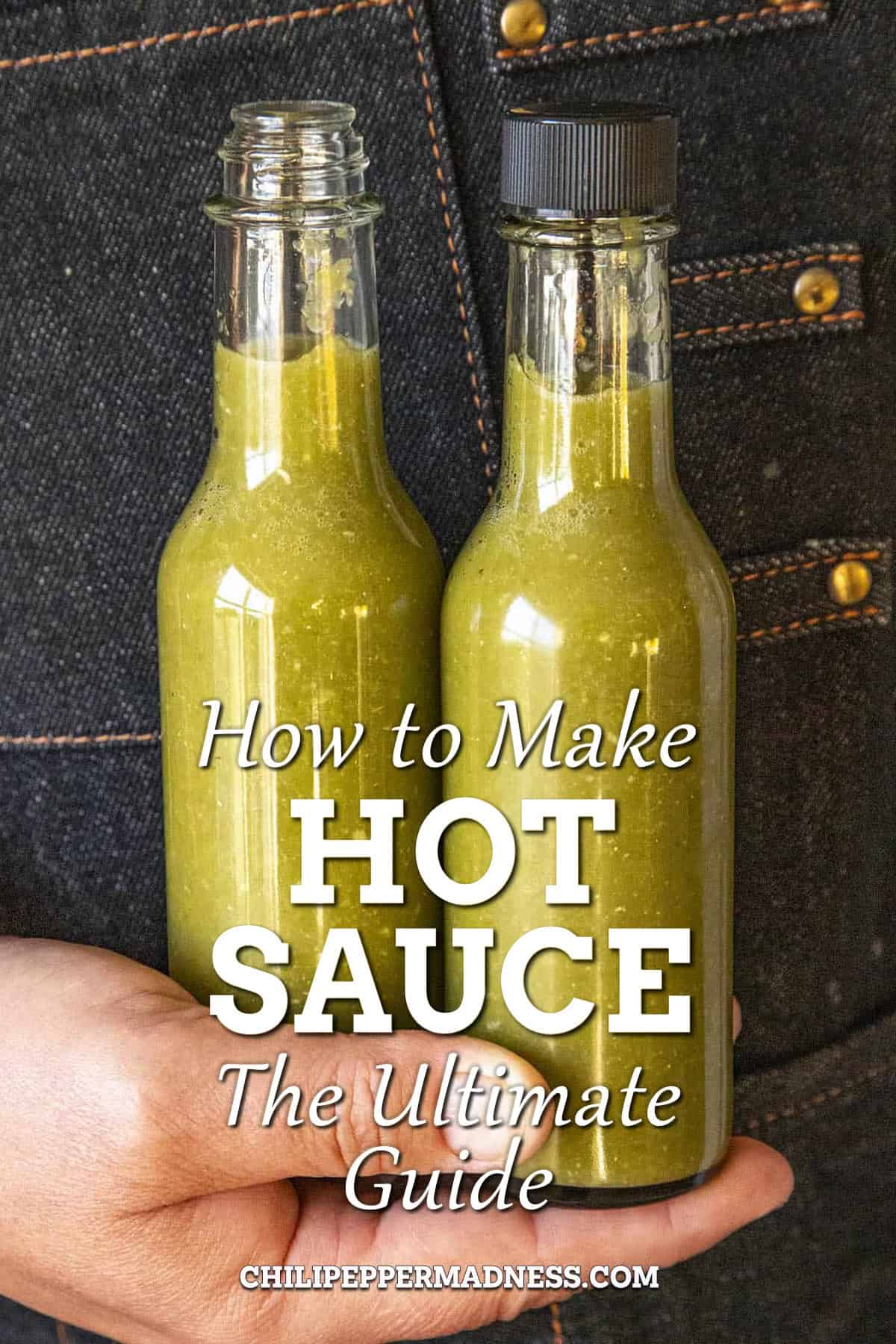
How to Make Hot Sauce - with Hot Sauce Recipes
The popularity of hot sauce in the United States has exploded in the last twenty years, and it shows no signs of slowing down. What used to be a market dominated by only a few hot sauce options with interesting fringe hot sauces is now a market filled with a wonderful selection of hot sauces for consumers.
Gone are the days of a single brand or two filling the hot sauce shelves.
I receive emails and comments all the time related to making hot sauce. People want to know how to make hot sauce at home. Some people want to learn how to take their hot sauce making hobby and turn it into a business.
I have many hot sauce recipes on the site, but the following is a discussion of hot sauce making in general.
It all starts with an essential ingredient – chili peppers.
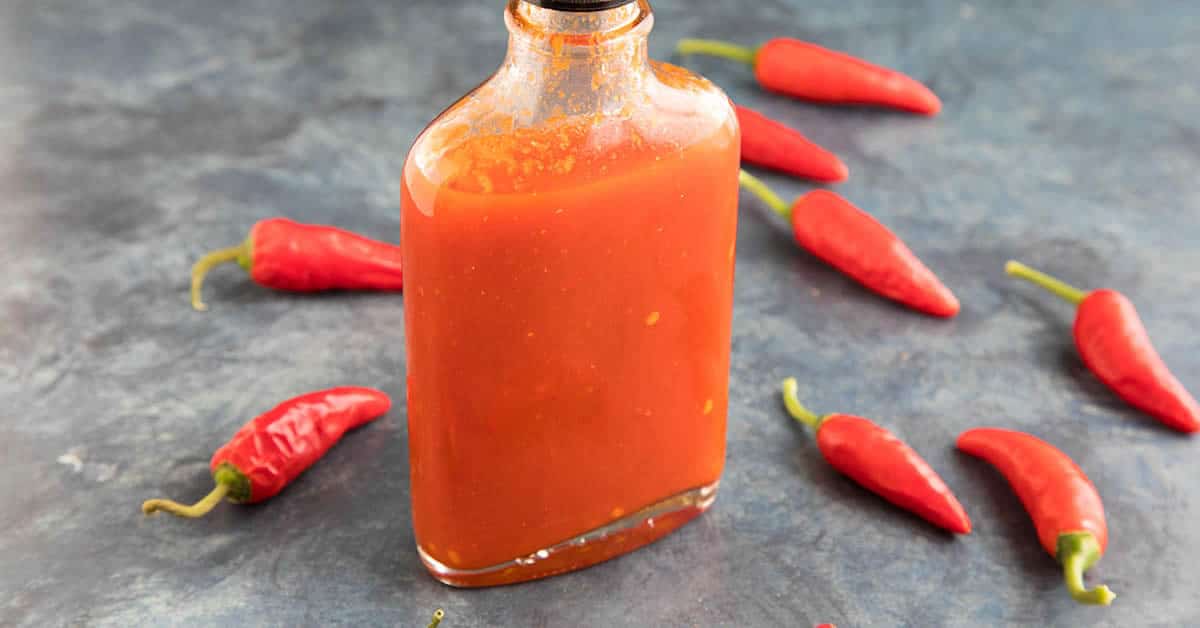
Chili Peppers and Hot Sauce
Chili peppers are essential to so many cuisines around the world. Often that chili pepper flavor, spice and sometimes heat becomes synonymous with a particular culture.
Chili peppers exude charisma and a mystique that is simultaneously exotic and down-home, and without them we wouldn’t have some of our favorite dishes and condiments, one in particular that is very close to my heart – HOT SAUCE.
I enjoyed hot sauce as a kid, but didn’t discover the wide world of artisan hot sauces until well into my twenties. Recently married, I became interested in cooking and my appetite for spicy food was in full bloom.
I found some outstanding hot sauces with the craziest labels, some of them serious, some of them funny, plowed through them by the case, and quickly became interested in making my own.
There is a bit of an art to making hot sauces, but it isn’t a difficult thing to do. It is mostly about combining chili peppers with other ingredients to achieve a particular flavor.
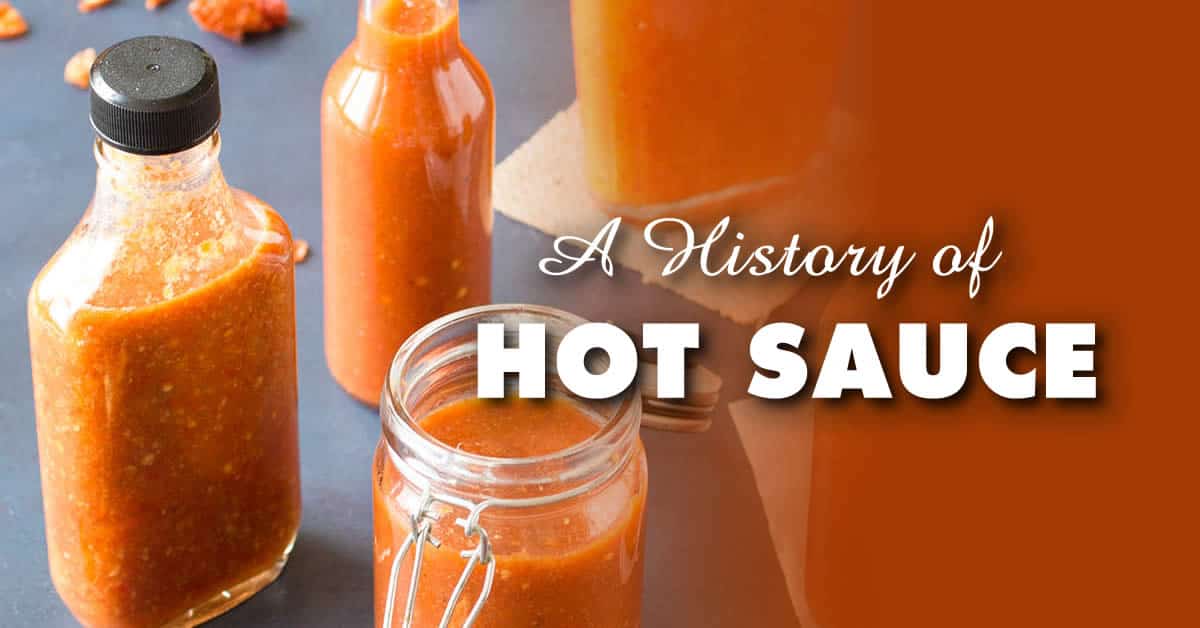
History of Hot Sauce
Chili peppers have been harvested for thousands of years, and it is known that when Columbus landed in Haiti and the Dominican Republic in 1492, he found the Arawak people using peppers extensively. They preserved meats with peppers and cooked them into almost every meal.
The first advertisement for a commercial hot sauce in the United States seems to be in Massachusetts in 1807 by a farmer for a cayenne sauce.
It was Edmund McIlhenny, a banker from New Orleans who popularized hot sauce in the American culture. He fermented Tabasco peppers and aged them, strained and mixed them with vinegar, and began to sell it to local markets.
McIlhenny’s sauce became the famous “Tabasco” hot sauce that we know today.
Reasons to Make Hot Sauce at Home
I started making hot sauces at home because I had fallen in love with many of the artisan hot sauces out there, but sometimes couldn’t find them, and I wanted to experiment with different flavors.
When you make your own hot sauce at home, you are free to incorporate whatever ingredients that please you.
Also, you’re free to emphasize particular flavors that other sauces don’t offer, such as more superhot chili peppers or a batch that focuses heavily on fruit. In this way, making your own hot sauce guarantees it will be unique.
It’s also incredibly fun and satisfying.
I enjoy spending time in the kitchen, cooking up batches of hot sauce, and it makes me happy when I finish a new batch, freshly bottled. I set them into my refrigerator with a sense of happiness knowing that I will have a new hot sauce for months to come.
Making hot sauce is also a great way to preserve your chili pepper harvest. I grow a good sized pepper garden each year and while I cook with and preserve them in many different ways, I have yet to find a chili pepper that can’t be made into a wonderful hot sauce.
Even mild peppers can create flavorful sauces.
See How to Preserve Chili Peppers for further information.
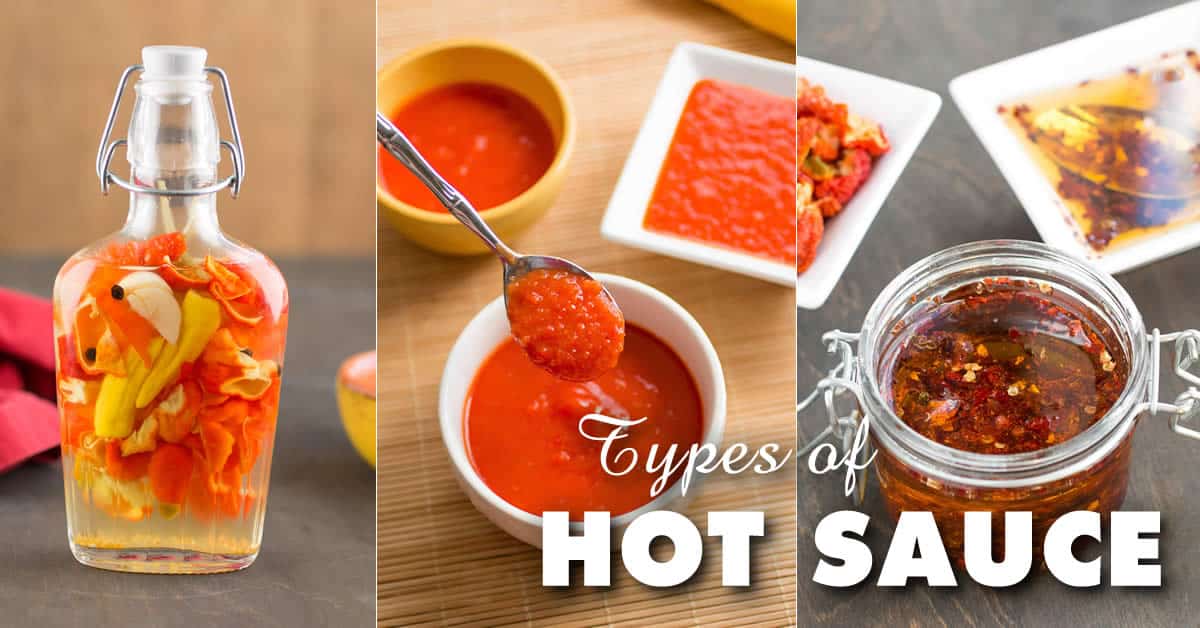
Types of Hot Sauces
I’ve never seen a definitive list of hot sauce types, and hot sauces vary from region to region.
Hot sauce has countless variations, such as cooking technique, the consistency of the peppers, the preparation of the peppers (fermented, fresh, dried, roasted, pan cooked) the actual types of peppers used in the hot sauce, the use of other ingredients and more.
The most basic division with hot sauces is whether or not the peppers are blended with the other ingredients. Sometimes they are, sometimes they are not.
Here is a list of popular hot sauce types:
Louisiana Style – This hot sauce, popularized by hot sauces like “Tabasco” and “Crystal”, is made with fresh or fermented peppers that are mashed with salt and vinegar. I make a lot of hot sauces this way, with both fresh and fermented peppers.
Caribbean Style – Usually made with fiery habaneros or Scotch Bonnet peppers, these sauces vary wildly because of the diverse culinary influences in the area. You’ll find hot sauces with African influence, and others with French influence nearby, as well as Indian influence and more. The ingredients reflect this.
Hawaiian Style – Hawaiian hot sauce, or “Hawaiian Chili Pepper Water”, is typically a mixture of local chili peppers, garlic, ginger, a bit of vinegar but mostly water, among other potential ingredients. It is splashed over everything. It is reminiscent of the famous “Puerto Rican Hot Sauce – Pique”.
American Southwest – You’ll find many earthy ingredients with thick walled New Mexican peppers, either fresh or dried, with very little use of vinegar. In New Mexico in particular, they serve up “red” or “green” chili sauce all year long.
Mexican Style – You’ll notice a lot of crossover from Mexican cuisine and the American Southwest and Tex-Mex cuisine. These hot sauces are made with lots of smoked and/or dried pods as well as local ingredients. They usually focus more on flavor and less on heat.
Madagascar Style – In Madagascar, the locals serve "Sakay", which means "spicy" in Malagasy, with many of their meals. Cooks there do not commonly cook with heat, but serve it on the side as a condiment or dipper. It is made primarily with peppers, oil and vinegar, then adjusted with other ingredients to taste.
South American – Here you’ll find some interesting and flavorful hot sauces, from Peruvian Aji Amarillo sauce to Chilean Pebre (herb and oil based with peppers) to Molho de Pimento (peppers and vinegar), and many, many more.
Asian Style – Asia is a huge area with a numerous cultures, so it is difficult to characterize their hot sauce collectively, though many Asian hot sauces and sauces are thick and used as chili pastes or chili oils.
In Thailand, Sriracha Hot Sauce is the most famous, made primarily with ground chilies, garlic, vinegar, sugar, and salt. In Korea, Gochujang is quite famous, made from chili powder and fermented glutinous rice.
Sambal - hugely popular in Indonesia, Malaysia and Singapore – is the generic term for local chili pepper sauces and hot sauces. They vary in heat level and in ingredients used.
Middle Eastern Style – Chili peppers are popular for sauces in the Middle East with sauces such as Harissa (a flavorful chili paste), Muhammara (a hot pepper dip), Shatta (a chunky pepper sauce), and Zhug (an herb and oil based sauce with peppers), with flavors of Middle Eastern spices.
African – the most famous African hot sauce is Peri Peri Sauce, which is made from African Bird’s Eye chili peppers. It is thick and flavorful with a nice level of heat.
Indian Style – India is well known for lot of spices, and use them in chutney and general everyday sauces and dips.
European Style – I’ve encountered Hungarian Hot Paprika as well as Ajvar (pronounced “eye-var” – smoky roasted red peppers with sometimes eggplant), which is a Balkan sauce. It is more like a spread. There is a very hot version, call Lutenica (aka "Ljutenica" - "Luto" means "hot"), made with peppers, carrots, garlic, oil, sugar, salt, tomatoes, and sometimes eggplant, though interpretations exist from region to region.
There is also Hungarian “Eros Pista” (Strong Steve), made primarily of minced paprika peppers and salt. Spain cooks with a lot of peppers and some of their hot sauces include Samfaina (like a French ratatouille), Sofrito (peppers with tomato, garlic, onions and oil) and Mojos (herb and oil based with peppers, sometimes). Italy does have hot sauces, such as the famous Diavolo sauce, made with spicy chili flakes or peppers.
Superhot Style – There is a lot of crossover between other styles of hot sauces, but these hot sauces are always made with superhot chili peppers, those that are 1 Million Scoville Heat Units and above, like the ghost pepper, scorpion peppers, 7 pots and the Carolina Reaper, which is the hottest chili pepper in the world currently.
Again, this is not an exhaustive list, as I could include different types of sauces, chili oils and more, so for the curious minded, I suggest following the peppers into other parts of the world and discover what the locals are cooking.
You’ll without a doubt discover some very interesting hot sauces made with local ingredients.
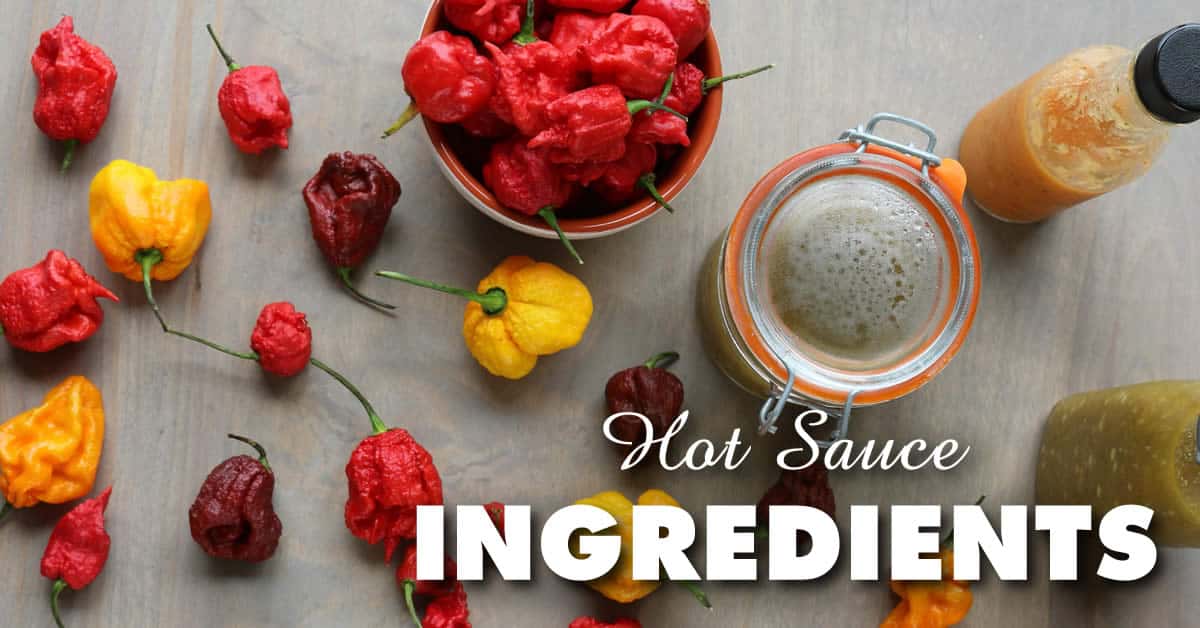
Typical Hot Sauce Ingredients
At its most basic form, hot sauce is typically a mixture of chili peppers and some sort of liquid, such as vinegar, citrus, or even water. You can mix those two together and you’ve got yourself a hot sauce.
Will it be great? Maybe. Could it be better? Of course.
When you incorporate other ingredients, you begin to develop a flavor profile, and one sauce may work for one particular dish over another. It is the combination of those ingredients that makes hot sauce making fun and interesting.
Some common ingredients for making hot sauce include:
- Chili peppers
- Vinegar
- Citrus juice – lemon, lime, orange, grapefruit, pineapple, etc.
- Fruit
- Vegetables
- Seasonings
- Salt
The Chili Pepper Factor – Bringing the Hot Sauce Heat
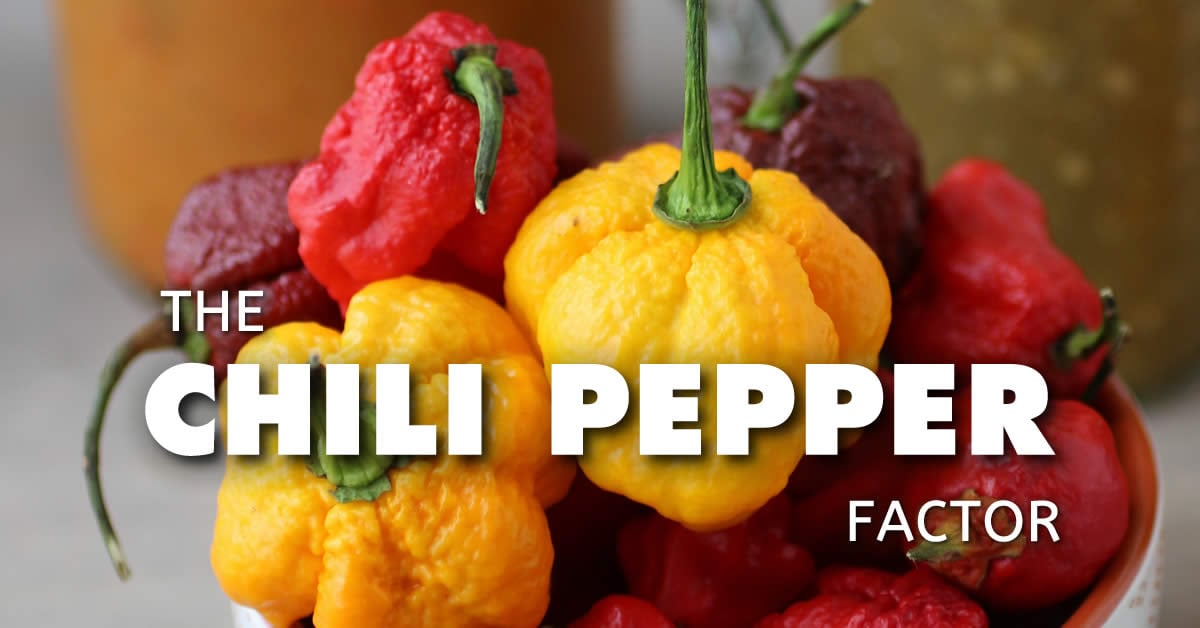
Making Hot Sauce from Fresh Peppers
There is a MASSIVE variety of chili peppers available to you for hot sauce making, with a range in not only heat but flavor. You can mix and match peppers as well for interesting combinations and heat levels.
Think anywhere from jalapenos to serranos to cayenne peppers to Thai peppers, habanero peppers, superhot peppers like 7 Pots, scorpions, the Carolina Reaper and so much more.
Making Hot Sauce from Dried Peppers and Powders
You can also use DRIED chili peppers, either whole or as powders. Certain dried peppers make for hugely flavorful sauces and hot sauces, particularly Mexican varieties like anchos or pasillas. Same goes for powders, which can turn into beautiful hot sauces.
Learn much more about how to make hot sauce from dried peppers here and how to make hot sauce from chili powders here.
Vinegars and Acids
Vinegar is another interesting variable. There are different types, such as white wine vinegar, red wine vinegar, apple cider vinegar and malt vinegar. Each has its own character and will affect the flavor of your final hot sauce, as does your choice of citrus.
A hot sauce made with lemon juice will taste substantially different from a hot sauce made with orange juice.
Fruits and Vegetables
Vegetables and fruits are commonly used ingredients. Tomatoes are widely popular for their depth and versatility, as are carrots for their surprising sweetness and substance. Fruits add sweetness and character.
Citrus fruit is very commonly used, as is pineapple and mango, though I have experimented with hot sauces made from kiwi, papaya, coconut and more.
Seasonings and Salt
There is nothing more widely variable than seasonings. There are different blends and combinations from all over the world, so you have many, many options. A favorite of mine is to use homemade powders from peppers that I have smoked and dehydrated.
Salt is ubiquitous. It belongs to the seasoning category, but salt is unique in that it also acts as a preservative for your hot sauce, along with vinegar and citrus.
With all of these ingredients, you have a near infinity of options for making a unique hot sauce.
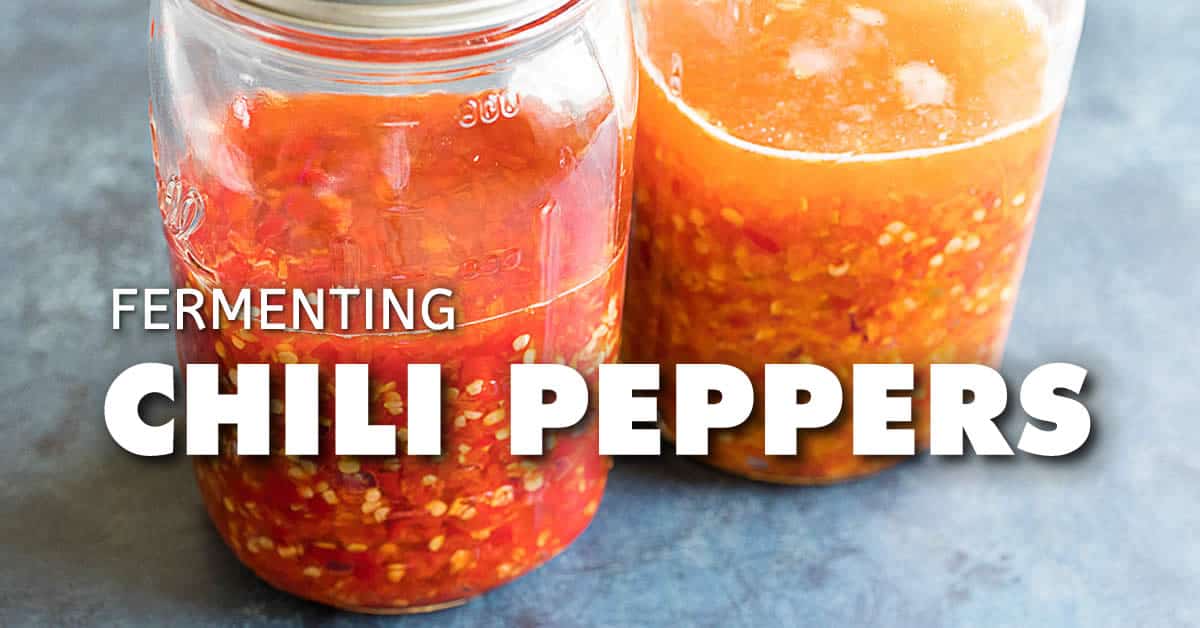
Fermenting Peppers for Making Hot Sauce
Fermenting chili peppers is a popular way to make hot sauce. Fermentation is the natural process of breaking down the peppers with micro-organisms into a more digestible form.
If you’ve ever enjoyed Tabasco sauce, you’ve tasted fermented chili peppers. Tabasco starts with tabasco peppers which they crush, mix with salt, and ferment in oak barrels for up to 3 years. The original Tabasco sauce only uses 3 ingredients – tabasco peppers, salt, and distilled vinegar.
A number of hot sauce makers use fermented peppers in the form of pepper mash to make their products, and a good pepper mash makes a difference in the resulting flavors.
Learn more about How to Ferment Chili Peppers Here or try this Fermented Hot Sauce Recipe.
A big question I often receive from would-be hot sauce makers is –
Should I ferment or use fresh peppers?
My answer is – BOTH!
I’ve made hot sauces using both techniques and I do not have a preference. Fresh chili peppers offer a big range of flavors and heat.
Fermented peppers are mellower and often have more depth of flavor in comparison, but I wouldn’t say better flavor. Just different, more nuanced in a way.
Either way, I encourage you to try fermenting chili peppers and making hot sauces from the resulting mash. Then, decide for yourself if it is worth it to you.
Fermentation does take some time, usually a couple weeks minimum, for the peppers to properly break down, though you can easily go longer.
I often ferment my peppers for 6 months at a time for making hot sauce the next spring after my last harvest. See my
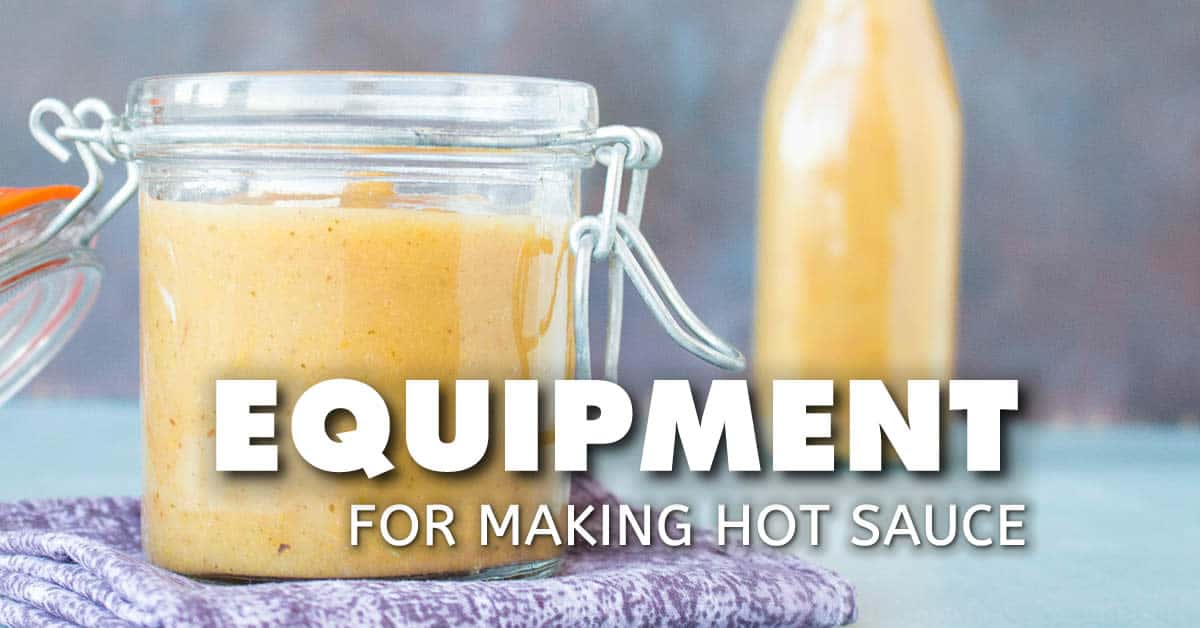
Equipment Needed for Making Hot Sauce
You don’t need a lot of fancy cooking tool to make hot sauce at home, just a few basic things.
- A good nonreactive pot for cooking the sauce
- Food processor or blender
- Glass jars or bottles
- Strainer
- Kitchen scale, for measuring peppers and other ingredients
- PH strips or PH meter (affiliate link, my friends)– this is useful for checking the final acidity of your hot sauce
- Latex gloves for handling hot peppers
Safety Advice
When working with hotter peppers, including superhots, it is important to wear gloves when handling the peppers both in raw and dried forms. The oils can get on your skin and cause burning sensations. See above.
Need help? How to Stop the Chili Pepper Burn On Your Skin.
Also, the fumes from the chili peppers and/or the fine powders may get into the air if you are not working in a well ventilated room, so you may want to wear a mask and goggles. Superhot chili peppers, truly, are called superhots for a reason.
A Basic Hot Sauce Recipe – Let’s Make Some Hot Sauce!
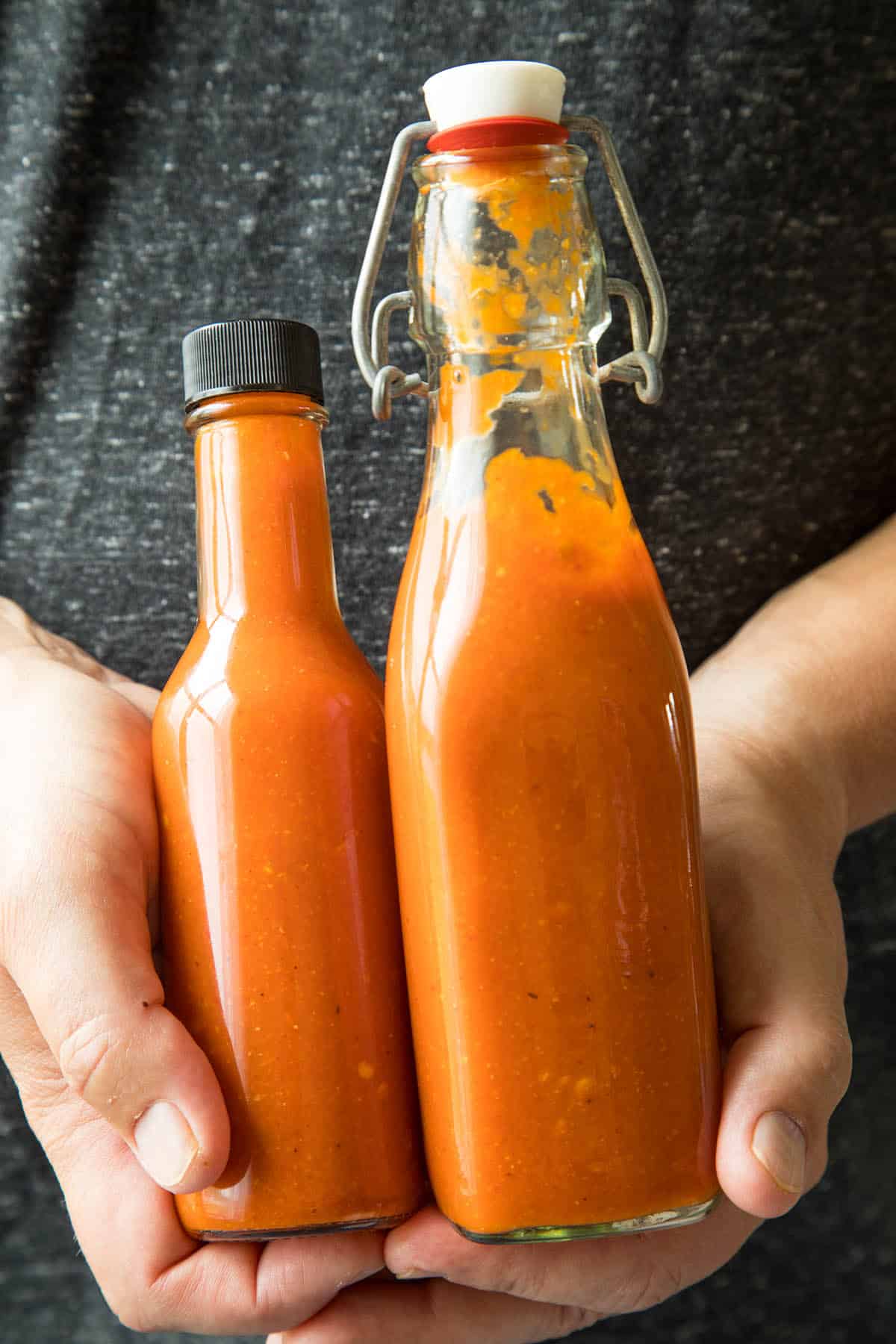
Here is a very simple hot sauce recipe that you can use a base. It is a non-fermented recipe made Louisiana style with only chili peppers, vinegar and salt.
Ingredients
- 1 pound fresh chili peppers of choice
- ½ - 1 cup vinegar
- 1/2-1 tablespoon salt
Cooking Directions
Wash the peppers and remove the stems. Remove the seeds, if desired. Add them to a food processor along with the vinegar and salt and process until smooth.
Add the mixture to a pot and bring to a quick boil. Reduce the heat and simmer for 15 minutes to allow the flavors to develop.
Remove from heat and cool. Add them to serving bottles, or strain out the pulp first for a much thinner sauce and bottle.
Makes about 2 cups or so of hot sauce.
Obviously you can change things up A LOT with this recipe, as discussed in the ingredients section below. You can introduce a mixture of peppers of varying flavors and heat levels, add in vegetables like tomato, onion, garlic, and/or carrots for big flavors, try fruit for sweetness, toss in interesting seasonings, and so much more.
A List of Hot Sauce Recipes
You can always check out my Hot Sauce Recipes and Sauce Recipes sections of the site, but here is a good list for you to draw from, with different styles and techniques from all over the world.
- Aji Chili Sauce
- Ancho-Jalapeno Hot Sauce
- Caribbean Jerk-Peach Hot Sauce
- Caribbean Style Mango-Habanero Hot Sauce
- Carolina Reaper Hot Sauce
- Chermoula
- Chimichurri
- Chimchurri Rojo
- Cuban Mojo
- Datil Pepper Sauce
- Devil's Tongue Hot Sauce
- Fermented Aji-Garlic Hot Sauce
- Ghost Pepper Hot Sauce
- Habanero Hot Sauce
- Hawaiian Chili Water
- Homemade Buffalo Sauce
- Homemade Cayenne Pepper Sauce
- Homemade Chili-Garlic Sauce (like Asian Huy Fong chili-garlic sauce)
- Homemade Fire Cider
- Homemade Harissa
- Homemade Tabasco Sauce
- Homemade Sriracha (both fermented and non-fermented varieties)
- Honey Roasted Hot Pepper Hot Sauce
- How to Make Louisiana Style Hot Sauce
- Jamaican Scotch Bonnet Pepper Sauce
- Peach-Scotch Bonnet Hot Sauce
- Peri Peri Sauce
- Puerto Rican Pique
- Roasted Red Hatch Chile Sauce
- Roasted Red Jalapeno Hot Sauce
- Salsa Roja
- Salsa Verde
- Spicy Serrano Hot Sauce
- Sweet Pepper Chili Sauce
- Ti-Malice - Hatian Creole Hot Sauce
- Sambal Oelek
- Scotch Bonnet Curry Hot Sauce
- Southwest Creamy Jalapeno Sauce
- Superhot Hot Sauce (The Hottest Damn Hot Sauce I Ever Made)
I will keep adding to this last as I make the sauces. There are so many! I love it.
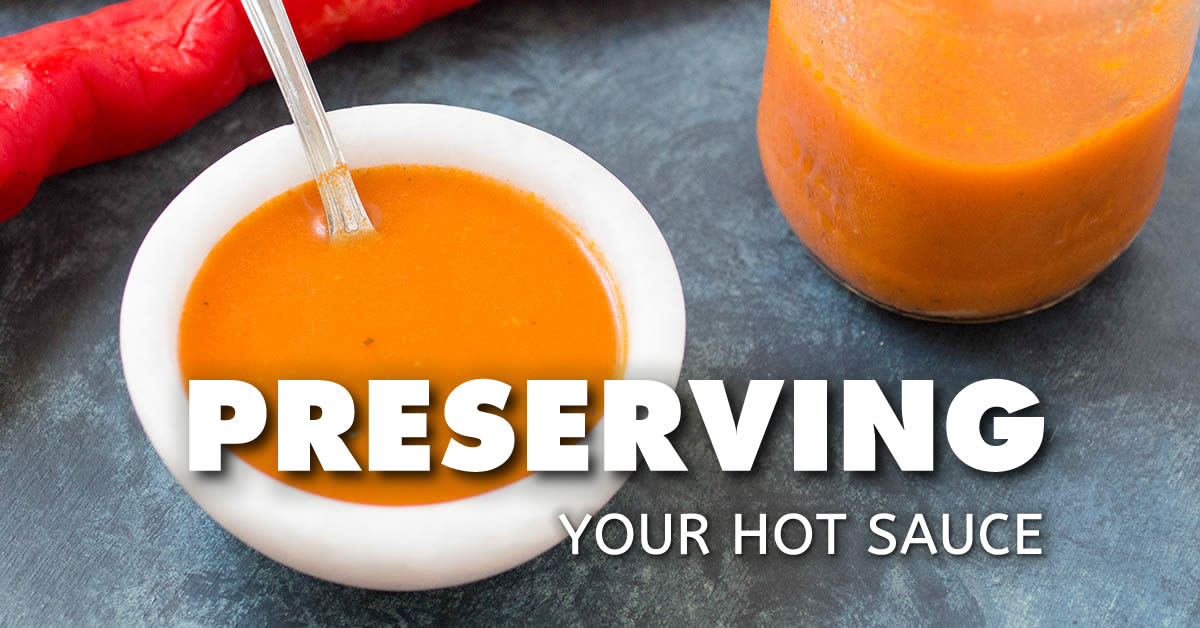
Preserving Your Hot Sauce – It’s all about the Acidity
By far one of the most common questions I receive about hot sauce making is – how long will this hot sauce keep? Can I bottle or can it to keep it longer?
The answer it all about the PH level of the hot sauce. It should keep a few months easily in the fridge, or even longer. It’s all about the acidity. To be technical, target level ph for shelf stable foods is below 4.6 ph, but should probably be lower for home cooks, around 4.0 or so, to account for errors. Many home hot sauce makers prefer 3.5 or lower.
If you’re concerned, add more vinegar to lower the ph. Sauces made with fermented chili peppers will last even longer.
You can measure ph levels with ph strips or a good ph meter, which you can pick up from Amazon or other retailers. As I can’t vouch for the accuracy of them, however, it is best to shoot for a lower acidity as mentioned, around 4.0 or lower. 3.5 is idea. The PH meter I use and love is from Thermoworks, where I am an affiliate. Check out the Thermoworks PH Meters here (affiliate link, my friends).
And yes, you can process your hot sauce either in a hot water bath or with a pressure canner. Just be sure to use proper canning/jarring safety procedures.
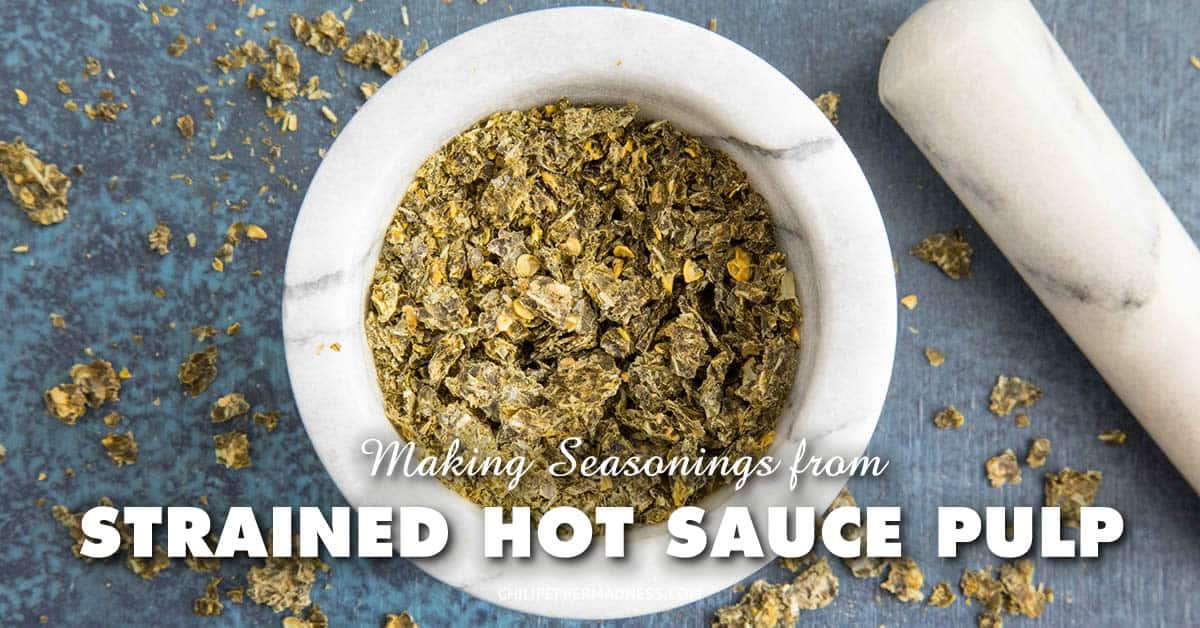
Using the Leftover Pulp from Straining Hot Sauce
With certain hot sauce recipes, you have the option to strain the sauce to thin it out and remove the chunky stuff. What remains is a pulp of the ingredients used to make your hot sauce.
Do not throw that pulp away! It is a rich collection of flavorful ingredients and there is plenty of life left in it. You can dehydrate it to make a homemade seasoning blend. Isn’t that awesome?
I’m a huge advocate for dehydrating – I am the author of “The Spicy Dehydrator Cookbook” – and a huge advocate for making fun and interesting seasonings.
Essentially, spread the pulp out over dehydrator sheets and dehydrate it for 8-10 hours at 125 degrees F, or until it is completely dried through. Grind it up with a grinder or a mortar and pestle and save it in airtight containers. Use it as you would any seasoning blend.
Learn more at this page – Making Seasoning Blends from Strained Hot Sauce Pulp.
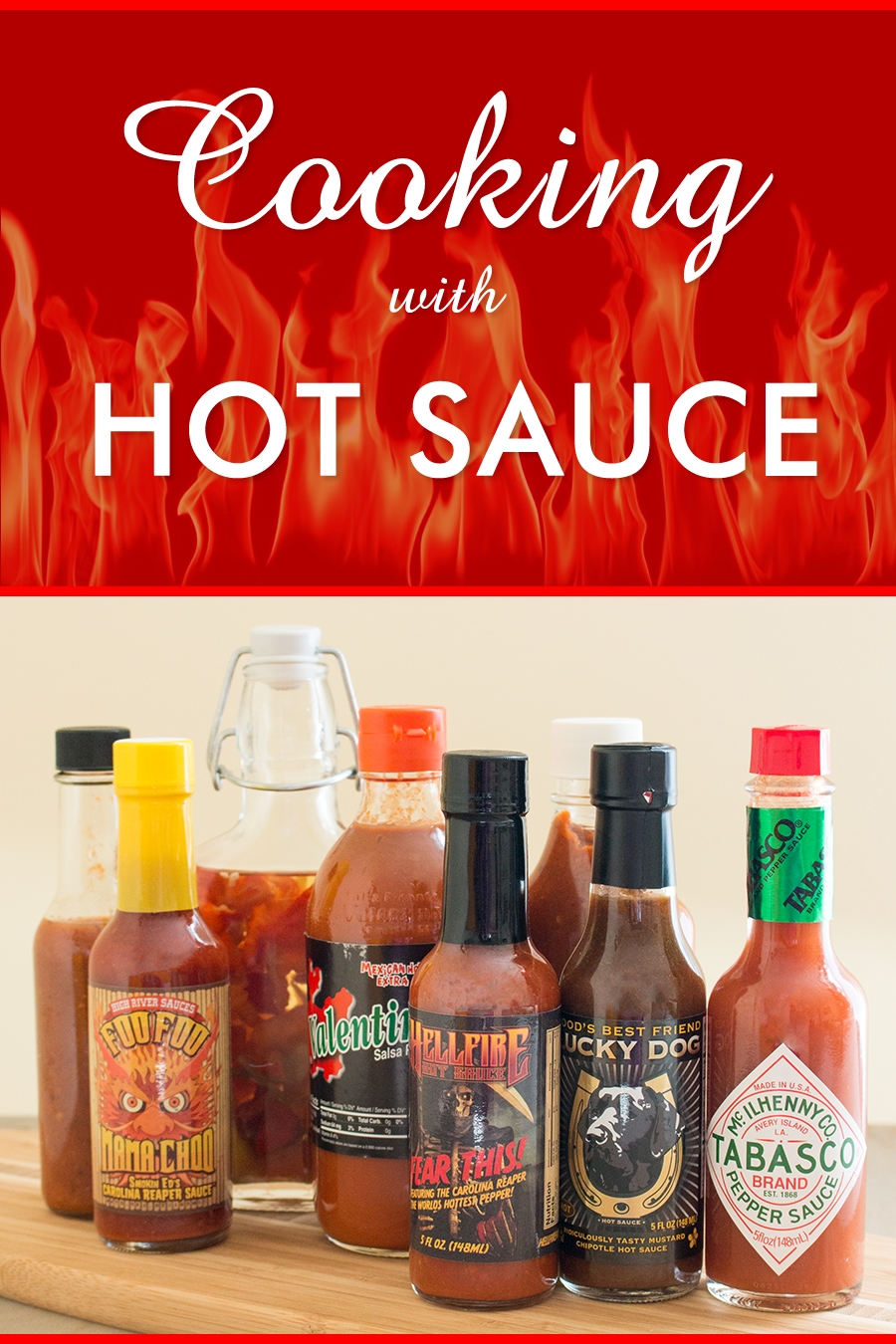
Cooking with Hot Sauce
Hot sauce doesn’t have to be a finisher only. Sure, it’s great for dashing over practically anything, but you can use it as a base as well. Here are some ideas for cooking with hot sauce to help you get going.
Hot sauces bring the zing to spicy cocktails, vinaigrettes and dressings, dips, pasta sauces, stuffed peppers, pots of chili, homemade mustards, Buffalo sauce (an essential ingredient), marinades and more.
You name it! Hot sauce can make it better.
Learn more at this page – Cooking with Hot Sauce.
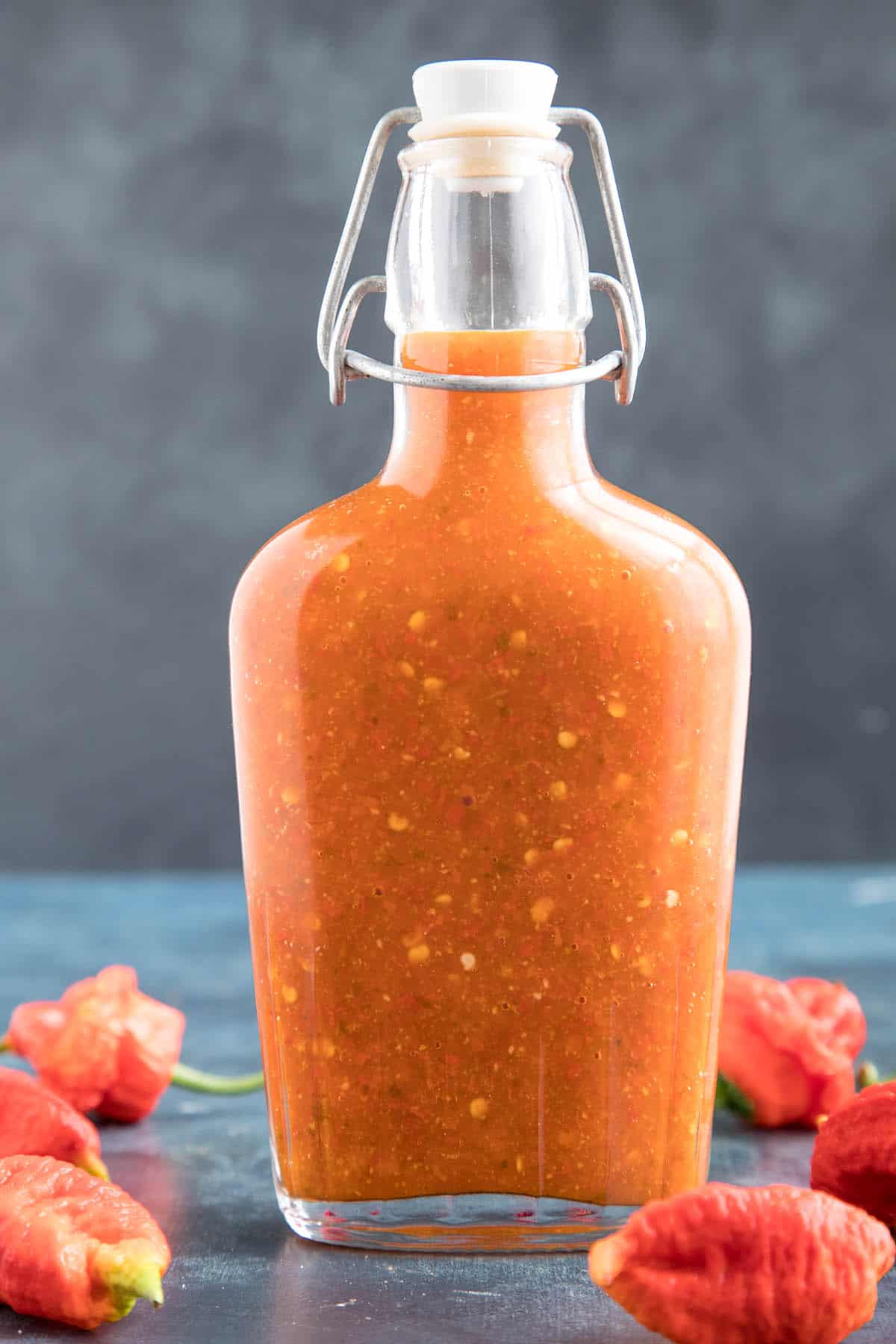
Some Hot Sauce Making FAQs
I get a LOT of questions about making hot sauce. Here are some of the most common.
Where’d you get those sauce bottles?
I find them locally sometimes, but I also order through Amazon. Here is a link to some bottles I like (affiliate link, my friends!): Swing Top Glass Bottles, 8.5 Ounce - Set of 4. If you like the smaller bottles that most hot sauce makers use, here's another link: Hot Sauce Bottles, 5 Oz - 24 Pack.
How Can I Make My Hot Sauce Thicker?
The best way to thicken a hot sauce is to limit the amount of liquid added in the beginning. Try adding in only a half of the recommended amount of liquid, then process the hot sauce. You can always add in liquid to thin it out more if it is too thick.
Also, don’t strain the sauce. Straining the pulp from your hot sauce will significantly thin it out.
However, if you’ve already made your hot sauce, strained it, and want to thicken it up, one way to do so is to simmer it over low heat. The heat will reduce the water content and it will thicken.
You can also incorporate a thickener, such corn starch, arrowroot, or xanthan gum by mixing a tablespoon or more with water, then swirling into the simmering hot sauce. This can affect the flavor, however, so be prepared. This is a classic way to thicken gravies.
How Can I Make My Hot Sauce Hotter?
The best way to make your hot sauce hotter is to incorporate a spicy chili powder. Of course starting with hotter peppers is the best method for this, but sometimes the process of making a hot sauce can tamp down some of that fresh chili pepper heat.
I like to keep several good hot pepper powders, like 7 Pot Power or Caroline Reaper Powder on hand to swirl into my sauces and foods to really spice things up.
How Can I Make My Hot Sauce Milder?
Diluting your finished hot sauce is the best way to tame the heat. If you’ve made a sauce and find that it is just too hot to consume, try making another batch without the peppers, if possible.
Incorporate carrots or tomatoes, then combine the two sauces for a milder overall sauce.
Adding sweetness can help, too. Try honey, agave nectar, or a bit of sugar or brown sugar, if those flavors fit the hot sauce. You’ll still get plenty of heat, but the sweetness helps to balance some of it.
Dairy is another way to combat the heat. Of course this will completely change the character of your hot sauce, but consider adding cream to help.
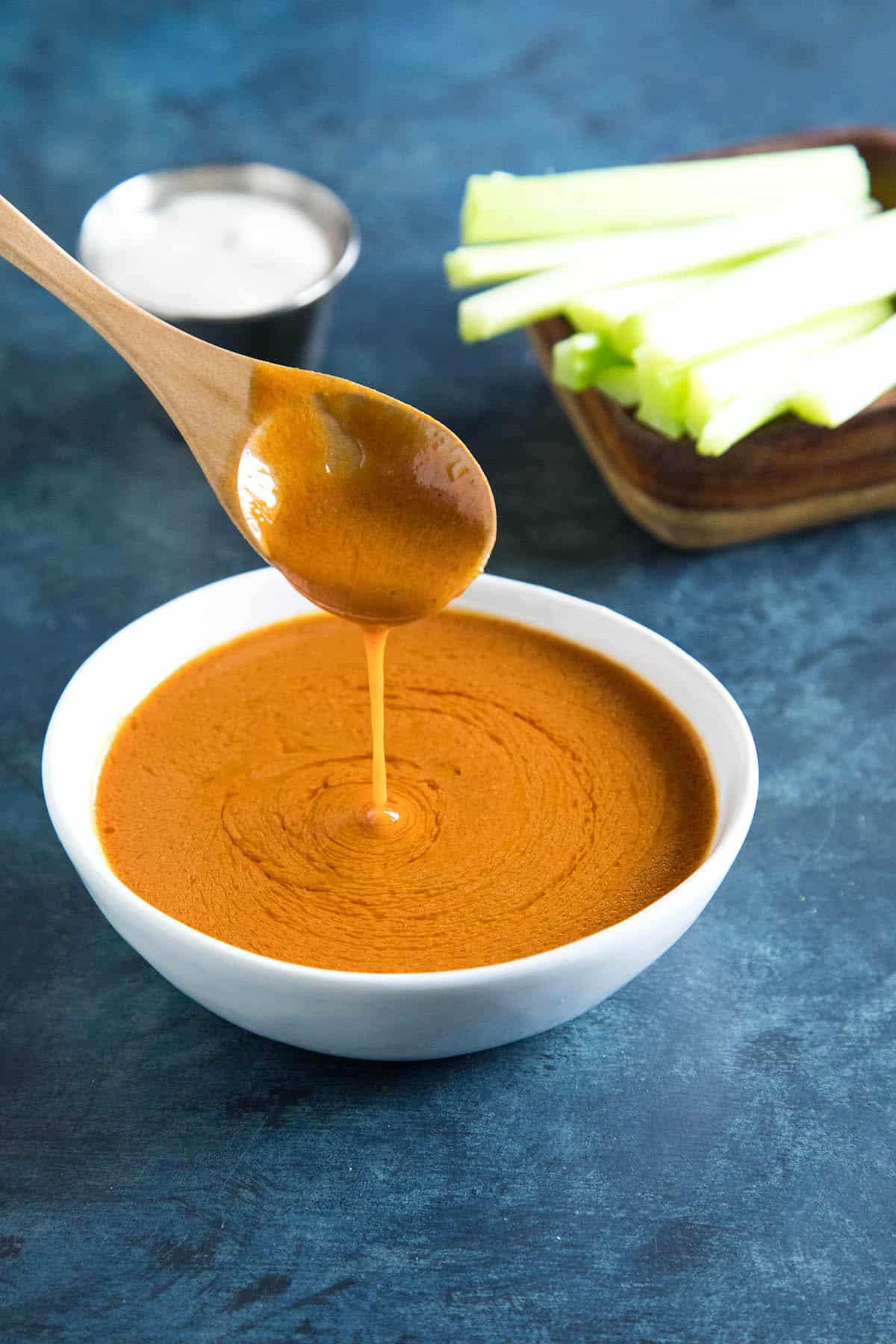
How to Make Hot Sauce for Wings?
Classic Buffalo style wing sauce is a slightly different thing from making hot sauce, but really, at its core it is a mixture of Hot Sauce and Butter. Just swirl in a few tablespoons of butter into your simmering hot sauce and you’ve got the makings of Buffalo Wing Sauce.
Starting Your Own Hot Sauce Business
Hot sauce making usually starts as a home kitchen hobby. For some, it develops into a true passion and even progresses into a business idea. There is a vibrant hot sauce market in the U.S. today, and wouldn’t it be wonderful to be a part of it, selling your own brand of hot sauce to the masses of spicy food lovers?
If you’ve reached this level, here are some steps and advice to consider when bringing your product to market.
Perfect Your Hot Sauce
This should go without saying, but your hot sauce needs to be the best hot sauce it can be. Test your recipes thoroughly. Invite friends over to give you a reaction. Try them out on acquaintances.
Get a lot of feedback, not only on the taste, but the color, heat level, smell and more. Take notes and listen. Your product is the most important thing.
Branding
How you market your sauce will greatly impact your overall sales. Carefully consider what you want to call your hot sauce. Do you want a more serious name? Or perhaps something funny? Something whimsical? Profound?
Born to Hula’s “Reaper of Sorrow” would get a different reaction if they had named it “Rectum Destroyer”.
What about labels? A professionally designed label will be perceived as more professional than a cheap label printed at home and slapped on a bottle.
Do Your Research
Learn more about how the market works (and sells!) by checking out other hot sauces and hot sauce makers. Go to hot sauce and spicy food shows and introduce yourself.
Hot sauce makers are some of the friendliest people I’ve ever met, and their passion for their products exudes. You’re guaranteed to meet someone happy to tell you their story and how they got into the business.
Production
If you’re going to sell hot sauce, the biggest question is, where will you make it? You’re going to need a commercial kitchen.
You can’t make large batch hot sauce out of your home kitchen and meet all FDA requirements, so research commercial kitchens in your area. You can often rent them by the day.
Or, Consider a Co-Packer
Instead of making the hot sauce yourself, some companies offer the services to take your recipe and make it for you in their own production facility.
For a fee, they will not only source the ingredients and make the sauce, but will bottle it and ship it to you with labels and all.
Consider your costs on such a service, but it can be a huge time saver.
Food Safety and Legal
If you’re going to sell your own hot sauce, you’ll need to ensure your new company follows all legal requirements.
Here is a good resource with links to Commercial Kitchens/Co-Packers, Federal Agencies, other Process Authorities, Nutritional Analysis, and Trade Groups to help get you started: https://cals.cornell.edu/occupational-environmental-health-program/pesticides/policies-certification-and-regulations
Advice from Hot Sauce Makers
I reached out to some of the hot sauce makers I know and asked them what advice they would give to would-be sauce makers looking to break into the market. Here is what they had to say.
“The advice I would give to would be sauce makers wanting to start a new business is this: Do your research. Initially do your research on food safety and take a food safety course and read pertinent information from both the FDA and local DOH. After that, decide if you want to manufacture yourself or co-pack. Again, research. Starting up is an investment and the more you know before you start shelling out money the less you waste making mistakes. Finally ask questions. There's tons of sauce makers that have been where you are and will be more than happy to answer questions, just don't expect them to to do your work for you. Finally test your sauces on people who will give you honest feedback. Friends and family will be biased for the most part. Honest feedback may save you from spending a lot of time and money on a sauce nobody wants. Be smart before you start.” – Jeremy Walsh, Bigfat’s Hot Sauce (www.bigfatshotsauce.com).
"I tell everyone that asks me this question is that you better be ready to work super long hours and have an extreme passion for the industry." - Steve Seabury, High River Sauces (www.highriversauces.com)
"On the light side I would say to remember all the people that said, 'This is great-you should get it in stores', and remind them of that when you need financing!" - Bill White, Slap You Silly Hot Sauce (www.slapyousilly.net)
Thank you, my friends, readers, and spicy food lovers. If you have any questions or comments, contact me any time or leave a comment below. I will be adding more information here as I acquire it. Good luck making your hot sauce! -- Mike H.
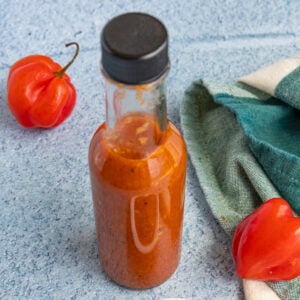
How to Make Hot Sauce (Easy Hot Sauce Recipe)
Ingredients
- 1 pound fresh chili peppers of choice
- ½ - 1 cup vinegar
- 1/2-1 tablespoon salt
Instructions
- Wash the peppers and remove the stems. Remove the seeds, if desired. Add them to a food processor along with the vinegar and salt and process until smooth.
- Add the mixture to a pot and bring to a quick boil. Reduce the heat and simmer for 15 minutes to allow the flavors to develop.
- Remove from heat and cool. Add them to serving bottles, or strain out the pulp first for a much thinner sauce and bottle.
- Makes about 2 cups or so of hot sauce.
Nutrition Information
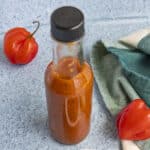



Megan says
I just made a batch of your Louisiana hot sauce! Thanks for being a resource to those of us who also love spicy foods and need recipes for sauces and spice blends.
Question: Specifically the LHS, but other sauces as well, do you recommend refrigerating or are some of these sauce recipes shelf stable?
Thank you again!
Mike H. says
You are very welcome, Megan. It depends on how you prepare them for storage. I do have a section called "Storage Information" for each sauce recipe, so check that one out. If something is missing, please leave me a comment on that recipe, and I will get back to you with the info ASAP! =)
Tim says
Do you have a tutorial for straining the sauce at the end? I made some tasty stuff, but it has too much tomato skin and Jalepeno skin that detracts from the experience. - Thanks!
Mike Hultquist says
Tim, you might check my Youtube Channel for hot sauces. I can't think of a specific one, though. For straining, I usually just use a mesh strainer and push the sauce through, then discard or dehydrate the solids. It might be good to get a better blender as well, which usually takes care of the skin/bits.
B Graves says
Great resource! I have gallons of habaneros and Carolina Reapers from this season and wanted to make sure I was doing this right! You break the process down simply and concisely. Glad I ran across the site. Thanks!
Mike Hultquist says
Awesome! Thanks so much!
steve edler says
hey mike,
two questions if i may. 1. if i add fruit to my recipe, when do i add it? do i add it before or after the cooking process? i plan on cooking it then straining the peppers to get a thin, liquid sauce. wasn't sure if the cooking process would weaken the flavors of the fruit.
2. is there any ratio of fruit to peppers or experimentation will be my guide?
thanks so much for your information.
steve
Mike Hultquist says
Hey, Steve. 1. I like to add fruit before cooking so they blend together, though it's something you can play with. 2. Check out my Hot Sauce Recipes section to see some of my hot sauces with fruits. I use some different ratios, but that's really something you'll eventually come to taste for preference: https://www.chilipeppermadness.com/chili-pepper-recipes/hot-sauces/ -- Have fun!
Paul:-) says
Hi guys,
Have you ever used Guava as a base for a hot sauce? I saw about 3 varieties in the halal supermarket close to my parents last weekend when I picked up (amongst other things) some lovely red habaneros and a Papaya which I made into a hot sauce earlier today.
I’m also toying with the idea of a Quince hot sauce too.
Paul:-)
Mike Hultquist says
Many fruits will work, Paul. It's definitely great for experimentation. I've used guava in other sauces.